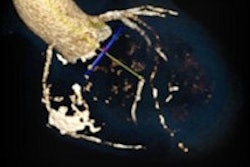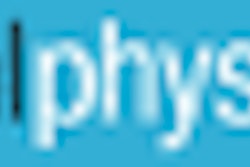
An established treatment for cancer patients can offer a novel therapeutic approach to decrease the levels of inflammation in the atherosclerotic plaques of patients with cardiovascular disease, German researchers have found.
The treatment is peptide receptor radionuclide therapy (PRRT) with radiolabeled somatostatin analogs, and currently it is used to treat patients with metastatic neuroendocrine tumors. Full details about PRRT's potential new application will be presented by Imke Schatka, a resident in the department of nuclear medicine at Hannover Medical School in Germany, during Wednesday's molecular imaging session at the International Conference on Nuclear Cardiology and Cardiac CT, which got underway yesterday in Berlin.
The discovery of overexpression of somatostatin receptors on neuroendocrine tumors first opened up the way for development of radiolabeled somatostatin analogs to image tumors during PET/CT scans, according to Schatka.
DOTATATE is a somatostatin receptor ligand targeting SSTR-2, a receptor known to be expressed on 70% of neuroendocrine tumors. It is used for molecular imaging and targeted therapy of tumors. Once tumors have been visualized, it is possible to target therapy by attaching the beta emitter lutetium-177 (Lu-177) to the ligand.
Active inflammation has been widely implicated in the initiation, progression, and disruption of vulnerable plaques, and consequently offers an emerging target for the imaging and treatment of atherosclerosis. The Hannover research team speculated that PRRT had beneficial effects on atherosclerotic plaque by reducing inflammation.
"Since SSTR-2 receptors are also expressed on macrophages, we speculated that DOTATATE-PET/CT might be used to detect vulnerable plaques and that a PRRT procedure could reduce inflammation in the arterial wall," Schatka explained.
The research team retrospectively identified 11 patients who had undergone PRRT treatment for various tumors. All had had three successive gallium-68 (Ga-68) DOTATATE PET/CT scans. They had received the beta emitter Lu-177 treatment after undergoing two consecutive scans with a third PET/CT scan following treatment.
Vessel wall uptake of the DOTATATE ligand was measured in six arterial segments of PET images. These segments included the carotid, aortic arch, ascending, descending, abdominal aorta, and iliac arteries segment. The overall vessel update was determined for each individual patient.
Findings showed that for the first PET/CT scan, the overall vessel uptake of the ligand correlated with the age of the patient and the number of calcified plaques. Vessel uptake was also higher in patients who had hypercholesterolemia. However, no significant differences in overall vessel uptakes were found between the first and second PET/CT scans. This confirmed reproducibility in the absence of treatment.
Significant reductions in the overall vessel uptake of the ligand occurred when the beta emitter Lu-177 was delivered following the second scan. This was shown in the third scan.
"Uptake of the ligand can be considered to be a measure of the quantity of SSTR receptors. This quantity is likely to correlate with the number of activated macrophages and the extent of the inflammatory process," Schatka noted. "Our results suggest that treatment has a beneficial effect in reducing inflammation."
Schatka stated the next step should be to obtain histological proof that reductions in inflammation really had been imaged with DOTATATE-PET/CT by looking at carotid artery samples removed from patients during routine surgery.



















